Books by Sonia Baelo-Allué

Routledge, 2021
Transhumanism and Posthumanism in Twenty-First Century Narrative brings together 15 scholars from... more Transhumanism and Posthumanism in Twenty-First Century Narrative brings together 15 scholars from five different countries to explore the different ways in which the posthuman has been addressed in contemporary culture and more specifically in key narratives, written in the second decade of the 21st century, by of these works engage in the premises and perils of transhumanism, while others explore the qualities of the (post)human in a variety of dystopian futures marked by the planetary influence of human action. From a critical posthumanist perspective that questions anthropocentrism, human exceptionalism, and the centrality of the 'human' subject in the era of the Anthropocene, the scholars in this collection analyse the aesthetic choices these authors make to depict the posthuman and its aftereffects. Sonia Baelo-Allué is Senior Lecturer at the Department of English and German of the University of Zaragoza (Spain) where she currently teaches US Literature and British and American Culture. Mónica Calvo-Pascual is Senior Lecturer at the Department of English and German of the University of Zaragoza (Spain) where she teaches Contemporary US Literature and British Culture.

London and New York: Bloomsbury/Continuum., 2011
This title offers a textual and contextual analysis of Bret Easton Ellis' most important works, f... more This title offers a textual and contextual analysis of Bret Easton Ellis' most important works, focusing on their reception, popular culture influences, and literary style. Both literary author and celebrity, Bret Easton Ellis represents a type of contemporary writer who draws from both high and the low culture, using popular culture references, styles and subject matters in a literary fiction that goes beyond mere entertainment. His fiction, arousing the interest of the academia, mass media and general public, has fuelled heated controversy over his work. This controversy has often prevented serious analysis of his fiction, and this book is the first monograph to fill in this gap by offering a comprehensive textual and contextual analysis of his most important works up to the latest novel "Imperial Bedrooms". Offering a study of the reception of each novel, the influence of popular, mass and consumer culture in them, and the analysis of their literary style, it takes into account the controversies surrounding the novels and the changes produced in the shifty terrain of the literary marketplace. It offers anyone studying contemporary American fiction a thorough and unique analysis of Ellis' work and his own place in the literary and cultural panorama.
The paperback edition was released on November 22, 2012: http://www.amazon.co.uk/Bret-Easton-Elliss-Controversial-Fiction/dp/1623562457/ref=sr_1_1?s=books&ie=UTF8&qid=1350729883&sr=1-1""

Amsterdam and New York: Brill/Rodopi., 2011
These essays discuss trauma studies as refracted through literature, focusing on the many ways in... more These essays discuss trauma studies as refracted through literature, focusing on the many ways in which the terms ‘cultural trauma’ and ‘personal trauma’ intertwine in postcolonial fiction. In a catastrophic age such as the present, trauma itself may serve to provide linkage through cross-cultural understanding and new forms of community. Western colonization needs to be theorized in terms of the infliction of collective trauma, and the postcolonial process is itself a post-traumatic cultural formation and condition. Moreover, the West’s claim on trauma studies (via the Holocaust) needs to be put in a perspective recuperating other, non-Western experiences.
Geo-historical areas covered include Africa (genital alteration) and, more specifically, South Africa (apartheid), the Caribbean (racial and gendered violence in Trinidad; the trauma of Haiti), and Asia (total war in the Philippines; ethnic violence in India compared to 9/11). Special attention is devoted to Australia (Aboriginal and multicultural aspects of traumatic experience) and New Zealand (the Maori Battalion). Writers treated include J.M. Coetzee, Shani Mootoo, Edwidge Danticat, Richard Flanagan, Janette Turner Hospital, Andrew McGahan, Tim Winton, and Patricia Grace. Illuminating insights are provided by creative writers (Merlinda Bobis and Meena Alexander).
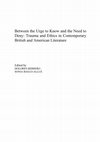
Heidelberg: C. Winter., 2011
Trauma and ethics are two terms inextricably linked. This book is concerned with trauma and its r... more Trauma and ethics are two terms inextricably linked. This book is concerned with trauma and its representations in contemporary British and American literature within the wider context of the ethics of writing, reading, and interpreting trauma and trauma narratives. More particularly, it analyses the connections between trauma, gender, identity, and genre issues. The contributors to this volume study the various modes of writing, genres, and generic conventions which have been used and/or subverted to represent traumas of different kinds in a selection of contemporary British and American novels. This collection will consequently deal with one of the most important concerns of contemporary academic criticism, namely, the ethical implications of the representation of trauma. Moreover, gender issues will also be given special attention, since many contemporary novels in English focus on the articulation of traumas resulting from the inequalities and abuses connected with identity and gender.
Journal Papers by Sonia Baelo-Allué

European Journal of American Culture. Volume 43, Number 3, pp. 219 - 238 , 2024
Trauma studies and posthuman studies are two paradigms that became popular in the late twentieth ... more Trauma studies and posthuman studies are two paradigms that became popular in the late twentieth century and have been used to define the culture of our time. Both fields deal with subjectivity, agency, embodiment and the relation with ‘the other’, viewing subjectivity and the self as shattered and fragmented. However, while trauma studies focuses on the process of acting out and working through to return to a sealed, complete conception of the self, posthuman studies explores the fluidity and interconnectedness that results from the decentralization of human subjectivity in our technological, boundary-blurring reality. This article introduces the concept of the posthuman trauma novel, which delves into the shared sense of vulnerability between trauma and posthumanism and the complex identity dynamics emerging from these paradigms. Formally, these novels favour complex timelines, non-linear narratives, interconnected plotlines, emotional detachment, machine-like narrators and thematic fragmentation, among other strategies. Patricia Lockwood’s No One Is Talking about This (2021) is a representative example of the posthuman trauma novel that navigates virtual and real worlds. Through fragmentation, intrusive images and non-linearity, the novel represents the disintegration of the mind caused by the internet and social media in which the sense of self is engulfed by a collective consciousness emerging from the never-ending scrolling and the juxtapositions between the important and the shallow. It is a real-world trauma that pulls the protagonist out of the virtual world of disembodiment and detachment. While acknowledging the importance of social media and digital technologies, the novel also sees the blurring of digital and physical spaces as a wound of modern subjectivity, a suffering that needs to be worked through to achieve an embodied and embedded conceptualization of the self.
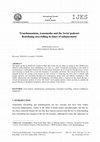
International Journal of English Studies, 2019
The digital age has facilitated the creation of fluid, open stories that are subject to change as... more The digital age has facilitated the creation of fluid, open stories that are subject to change as they unfold across different media platforms, each contributing to the story as a whole. Transmedia storytelling is also linked to transhumanism, a philosophy based on the idea that human limitations can be overcome through reason, science and technology to finally free us from the limitations of our bodies and minds. The concept of the literary has changed because the concept of the human has also evolved, as technology has been used to enhance both human capacities and storytelling through active participation, group work, and collective intelligence. This double enhancement that transmedia and transhuman storytelling entail is explored in this article through a textual and paratextual analysis of Serial, the world's most popular podcast, which can help us redefine the present blurring of disciplinary boundaries and the new territory of the literary.
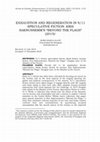
Revista de Estudios Norteamericanos, 2018
Early 9/11 fiction has often been criticised for focusing too much on the victims and on the loca... more Early 9/11 fiction has often been criticised for focusing too much on the victims and on the local aspects of the tragedy ignoring the global and political consequences of the attacks. 9/11 speculative fiction writers have taken longer to engage directly with the tragedy and when doing so they have also often adopted trauma-oriented approaches that could appease but not challenge. In 2015 Douglas Lain edited In the Shadow of the Towers: Speculative Fiction in a Post-9/11 World, a collection that shows how the idiom of the fantastic can be serious and meaningful and also a means to explore cultural anxieties in the United States. Within Lain's collection, this paper pays special attention to Kris Saknussemm's "Beyond the Flags," a story that combines cultural anxieties of our time and helps readers confront their own contradictions by questioning accepted assumptions like the sacred nature of the victims or the expected patriotism following a national tragedy. It also suggests new ways in which speculative fiction can offer original approaches to regenerate 9/11 fiction.
Atlantis: Journal of the Spanish Association of Anglo-American Studies, 2016
Since the 9/11 terrorist attacks a long list of novels concerned directly or indirectly with thes... more Since the 9/11 terrorist attacks a long list of novels concerned directly or indirectly with these events have been published. Psychic trauma literature has been especially popular among them, a fiction accused of solipsism and depoliticized discourse by being mostly unconcerned with the attacks' global context and political consequences. This essay does not ignore the importance of the trauma paradigm but focuses on cultural rather than psychic trauma and on Amy Waldman's The Submission (2011) as an example of the possibilities raised by the cultural trauma novel. Although rooted in the domestic and the personal, Waldman's novel transcends the shortcomings of psychic trauma fiction by exposing the cultural and political consequences of trauma, thus opening up a new path for future 9/11 fiction.

Although Don Delillo’s Falling Man (2007) has been one of the most influential 9/11 novels writte... more Although Don Delillo’s Falling Man (2007) has been one of the most influential 9/11 novels written to this day, it did not meet the expectations of reviewers when it was published. It is necessary to bear in mind that 9/11 can be understood both as a psychic/personal trauma and a cultural/collective one since it was a wound not only in the mind of those directly affected by the tragedy but also in the nation’s sense of identity. Despite DeLillo’s previous interest in cultural issues, he chose to write a 9/11 psychic —rather than cultural— trauma novel. Th is paper analyses the literary techniques and means of representation used in the novel to reflect the effects of traumatic memory and ponders the advantages and shortcomings of psychic trauma novels in the representation of traumas that affect society at large.
KEYWORDS: trauma studies; Falling Man; Don DeLillo; trauma fiction; 9/11 fiction; contemporary American literature

"http://rhr.dukejournals.org/content/2011/111/184.full.pdf+html
The 9/11 terrorist attack on... more "http://rhr.dukejournals.org/content/2011/111/184.full.pdf+html
The 9/11 terrorist attack on the United States has become one of the most represented disasters in history since it produced an unprecedented visual impact on those around the world who watched the second plane crash into the South Tower live on television. In an atmosphere in which reality resembled fiction, fiction was initially rejected as a suitable means for understanding and relating to the enormity of the events because it apparently had nothing to offer that journalism and the news could not provide. Ten years later, these initial misgivings have been overcome and 9/11 fiction has become a genre in itself. This essay explores the use of newspaper articles, radio transcripts, phone messages, e-mails, and interviews with eyewitnesses in Frédéric Beigbeder's Windows on the World (2004); the use of moving images—a flip book—and other visuals inserted in Jonathan Safran Foer's Extremely Loud and Incredibly Close (2005); and the references to well-known photographs of 9/11 in Don DeLillo's Falling Man (2007). These authors do not ignore the mediated nature of 9/11 but display it through the incorporation of other media in their fiction, which renders their representation of the trauma more effective."
Classical serial killer fiction and films offer their readers or viewers many sources of pleasure... more Classical serial killer fiction and films offer their readers or viewers many sources of pleasure: the control over disorder, the pleasure of pattern-discovering, the identification with a strong representative of the law, and of course the enjoyment, from the reader's secure position, of the murders as art or simply as an intellectual game. These narratives have the power of making us forget about ethics and the serious implications of murder, turning serial killing into a kind of aesthetic game that can be enjoyed as simple entertainment. However, what happens when ethics dominates over aesthetics in serial killer fiction? This question will find an answer through the analysis of Thomas Harris's The Silence of the Lambs (1988) and Bret Easton Ellis's American Psycho (1991), both dealing with serial killers although in entirely different ways.
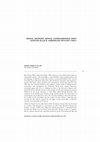
Bret Easton Ellis is a representative blank fiction writer whose novels deal with violence, indul... more Bret Easton Ellis is a representative blank fiction writer whose novels deal with violence, indulgence, sexual excess, decadence, consumerism and commerce. In American Psycho (1991) he focuses on the phenomenon of the serial killer. The aim of this paper is to look into the ways in which the seriality of the serial killer’s murders is linked to the seriality provided by different forms of mass culture: talk shows, daily news, advertisements, pop music, magazines and consumerism in general. Our society’s never-ending serial consumerism is mirrored by the serial killer’s never-ending killings. Taken to its last consequences, consumerism includes everything, which dehumanises people and blurs the difference between consuming objects and consuming human beings. The concept of seriality is deeply embedded in our culture, and is shared by serial killer fiction, mass cultural productions, and by consumerism, which may account for the current popularity of the serial killer.
Book Chapters by Sonia Baelo-Allué

Representing Vulnerabilities in Contemporary Literature. Miriam Fernández Santiago and Cristina M. Gámez Fernández, eds. Routledge Literary Studies. , 2022
Since the 21st century, our reliance on technology and its seamless integration in our lives is a... more Since the 21st century, our reliance on technology and its seamless integration in our lives is a natural consequence of the fourth industrial revolution in which all key emerging technologies—organized around the physical, the digital and the biological—co-evolve, fuse, and enrich each other (Schwab 2016; Klaus and Davis 2018). Similarly, critical posthumanists understand the human and the non-human as a continuum and see the organic body, the machine, and other material forms as relational, co-evolving and interdependent (Braidotti 2013; Herbrechter 2013; Nayar 2014). As the boundary between the human and the machine becomes porous and the dependence on Information and Communication Technologies (ICTs) increases, humans become especially vulnerable to their loss. Don DeLillo’s The Silence (2020) is analyzed through the double lens of posthuman and vulnerability studies by focusing on its aesthetics of melancholia and loss. The characters’ dependence on technology causes posthuman suffering, datafication and self-amputation as characters adopt the additive language of information to integrate in the infosphere. The sudden loss of ICTs in the novel traps characters in a process of melancholia as they not only mourn the loss of their digital connections but the unconscious, inaccessible loss of a constitutive part of their (post)human selves.

In: Herbrechter, S., Callus, I., Rossini, M., Grech, M., de Bruin-Molé, M., John Müller, C. (eds) Palgrave Handbook of Critical Posthumanism. Palgrave Macmillan. 10.1007/978-3-031-04958-3_40. , 2022
Although trauma studies and critical posthumanism have simultaneously developed, only in the last... more Although trauma studies and critical posthumanism have simultaneously developed, only in the last few years have critics started to see the imbrications of both disciplines. Trauma studies and critical posthumanism acknowledge that the traditional definition of the human as autonomous, exceptional, self-willed, and rational subject, distinct from and dominating other life forms, needs to be revised and reconfigured. Whereas classical trauma theory dwells on the wound and the fragmentation that human subjectivity has endured and is concerned with the process of “acting out” and “working through” that will lead to the reintegration of the self’s bounded internal equilibrium, critical posthumanism sees the wound as an opportunity to redefine subjectivity as relational, interdependent, and co-evolving with other bodies, machines, and material forms. In the last few years, classical trauma studies has evolved from a Eurocentric, event-based, static conception of trauma to a more embedded and embodied vision of the trauma process that takes into account the ties of humans to other organic bodies, machines, and material forms. In turn, critical posthumanism has found in trauma studies the vocabulary to understand and deal with the wound that moving beyond human exceptionalism and exemptionalism produces on us.
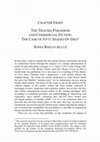
The Politics of Traumatic Literature: Narrating Human Psyche and Memory. Edited by Önder Çakırtaş, Antolin C. Trinidad and Şahin Kızıltaş. (Cambridge Scholars Publishing) , 2018
In this essay I want to explore the way trauma fiction conventions are used in commercial fiction... more In this essay I want to explore the way trauma fiction conventions are used in commercial fiction through the analysis of a literary phenomenon in terms of sales and media coverage: E. L. James’s 2012 erotic trilogy Fifty Shades of Grey, Fifty Shades Darker and Fifty Shades Freed. In 2015 a fourth book was published, Grey, but since it is a retelling of Fifty Shades of Grey from Christian Grey’s perspective I will mainly discuss the original trilogy. The books are mostly understood as erotic fiction which the press has labelled “mommy porn” for its mainstream success among female adult readers. The focus of this essay is not on the analysis of the cultural impact of the books, which has been widely explored in newspaper articles, magazines and academic studies, but on the role they play within contemporary trauma culture or the “trauma paradigm” that, according to Luckhurst, pervades our understanding of subjectivity and experience since trauma, extremity and survival have turned into privileged markers of identity (2008, 1-2). It is my contention that it is precisely the role that trauma plays in the story that may account for its mainstream success beyond the limited erotic market and that the trilogy’s use of trauma best exemplifies the possibilities it can offer in commercial fiction beyond the more literary trauma novel.

What does Twilight and Fifty Shades of Grey have in common? What can these two series of novels p... more What does Twilight and Fifty Shades of Grey have in common? What can these two series of novels possibly share? Twilight is a mostly chaste fantasy romance between a 104-year-old vampire and a teenage girl, whereas Fifty Shades of Grey is an erotic series dealing with a college graduate and a young business magnate who is into BDSM (bondage, discipline, sadism and masochism). Apparently they have a lot in common since both series have struck a chord in our society, becoming full-fledged cultural phenomena. Bearing in mind that Fifty Shades of Grey was in origin fan fiction of Twilight, this chapter deals with what happened since 2005, when Twilight was first published, and 2012 when Fifty Shades of Grey became the biggest hit, topping bestseller lists for months. There are both cultural and ideological implications emerging from the transformation that the Twilight series has undergone. From a set of novels and films written by a Mormon American author and addressing a young adult audience, Twilight has turned into Fifty Shades of Grey, an erotic saga labeled by the media “mommy porn,” written by a British fan of Twilight and addressing an adult female audience. The story of this journey is worth exploring in full since it also shows a common tension in contemporary culture, that between corporate-driven and consumer-driven processes, between commercial culture and grassroots creativity.

Invisible Monsters is the story of two siblings’ journey to discover their own identity and place... more Invisible Monsters is the story of two siblings’ journey to discover their own identity and place in a changing world. The novel can be defined as a blank fiction road story that lacks a point of departure and a point of arrival and whose main characters possess liquid identities that are created, shaped and changed as they travel up and down the West Coast. This is also a novel of secrets that need to be kept hidden, of pasts that should be erased, of futures that nobody wishes for and of traumatic presents of both amnesia and possibility. All these complex issues are dealt with in the framework of transgressive or blank fiction. The issue here is whether blank fiction, combined with the road story and the fluid sense of identity can really play an ethical role or, rather, if the ambiguities that narrative distance imposes prevent the belief in the power of generous love and resilience to transform identity.
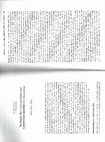
Glamorama is a complex novel in both thematic and narrative terms primarily due to Bret Easton El... more Glamorama is a complex novel in both thematic and narrative terms primarily due to Bret Easton Ellis’s use of intermediality as an expressive means to construct the personality of Victor, the main character in the novel, and to build up the climate of virtuality that frames the narrative and the terrorist plot. Intermediality—the convergence of literature, cinema, newspapers, television, and other popular culture and media forms—plays different roles in Glamorama. Initially, intermediality is firmly framed by the pattern and style of literary narration. References to films, print culture, images, and music contribute to the construction of characters and the depiction of their shallow lifestyles, particularly their obsession with always having an audience. As the novel progresses, intermedial references engulf Victor’s narrative voice, reflecting a struggle between different media for narrative control. In the course of the novel, a double of Victor is created that briefly usurps the narrative voice and the novel veers toward the virtuality that Baudrillard describes in The Perfect Crime.











Uploads
Books by Sonia Baelo-Allué
The paperback edition was released on November 22, 2012: http://www.amazon.co.uk/Bret-Easton-Elliss-Controversial-Fiction/dp/1623562457/ref=sr_1_1?s=books&ie=UTF8&qid=1350729883&sr=1-1""
Geo-historical areas covered include Africa (genital alteration) and, more specifically, South Africa (apartheid), the Caribbean (racial and gendered violence in Trinidad; the trauma of Haiti), and Asia (total war in the Philippines; ethnic violence in India compared to 9/11). Special attention is devoted to Australia (Aboriginal and multicultural aspects of traumatic experience) and New Zealand (the Maori Battalion). Writers treated include J.M. Coetzee, Shani Mootoo, Edwidge Danticat, Richard Flanagan, Janette Turner Hospital, Andrew McGahan, Tim Winton, and Patricia Grace. Illuminating insights are provided by creative writers (Merlinda Bobis and Meena Alexander).
Journal Papers by Sonia Baelo-Allué
KEYWORDS: trauma studies; Falling Man; Don DeLillo; trauma fiction; 9/11 fiction; contemporary American literature
The 9/11 terrorist attack on the United States has become one of the most represented disasters in history since it produced an unprecedented visual impact on those around the world who watched the second plane crash into the South Tower live on television. In an atmosphere in which reality resembled fiction, fiction was initially rejected as a suitable means for understanding and relating to the enormity of the events because it apparently had nothing to offer that journalism and the news could not provide. Ten years later, these initial misgivings have been overcome and 9/11 fiction has become a genre in itself. This essay explores the use of newspaper articles, radio transcripts, phone messages, e-mails, and interviews with eyewitnesses in Frédéric Beigbeder's Windows on the World (2004); the use of moving images—a flip book—and other visuals inserted in Jonathan Safran Foer's Extremely Loud and Incredibly Close (2005); and the references to well-known photographs of 9/11 in Don DeLillo's Falling Man (2007). These authors do not ignore the mediated nature of 9/11 but display it through the incorporation of other media in their fiction, which renders their representation of the trauma more effective."
Book Chapters by Sonia Baelo-Allué
The paperback edition was released on November 22, 2012: http://www.amazon.co.uk/Bret-Easton-Elliss-Controversial-Fiction/dp/1623562457/ref=sr_1_1?s=books&ie=UTF8&qid=1350729883&sr=1-1""
Geo-historical areas covered include Africa (genital alteration) and, more specifically, South Africa (apartheid), the Caribbean (racial and gendered violence in Trinidad; the trauma of Haiti), and Asia (total war in the Philippines; ethnic violence in India compared to 9/11). Special attention is devoted to Australia (Aboriginal and multicultural aspects of traumatic experience) and New Zealand (the Maori Battalion). Writers treated include J.M. Coetzee, Shani Mootoo, Edwidge Danticat, Richard Flanagan, Janette Turner Hospital, Andrew McGahan, Tim Winton, and Patricia Grace. Illuminating insights are provided by creative writers (Merlinda Bobis and Meena Alexander).
KEYWORDS: trauma studies; Falling Man; Don DeLillo; trauma fiction; 9/11 fiction; contemporary American literature
The 9/11 terrorist attack on the United States has become one of the most represented disasters in history since it produced an unprecedented visual impact on those around the world who watched the second plane crash into the South Tower live on television. In an atmosphere in which reality resembled fiction, fiction was initially rejected as a suitable means for understanding and relating to the enormity of the events because it apparently had nothing to offer that journalism and the news could not provide. Ten years later, these initial misgivings have been overcome and 9/11 fiction has become a genre in itself. This essay explores the use of newspaper articles, radio transcripts, phone messages, e-mails, and interviews with eyewitnesses in Frédéric Beigbeder's Windows on the World (2004); the use of moving images—a flip book—and other visuals inserted in Jonathan Safran Foer's Extremely Loud and Incredibly Close (2005); and the references to well-known photographs of 9/11 in Don DeLillo's Falling Man (2007). These authors do not ignore the mediated nature of 9/11 but display it through the incorporation of other media in their fiction, which renders their representation of the trauma more effective."